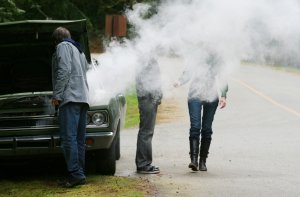Check the Coolant to Avoid Engine Damage
Did you forget to check the coolant in your vehicle again? Now, you find yourself standing on the side of the road while your car, truck or SUV blows off some steam. Ugh!
Avoid this sad situation and have the cooling system in your car serviced regularly. It takes hardly any time to check your antifreeze or coolant and top it off. Many garages, in fact, will check all your vehicle’s fluids, and add more liquid if needed, for the grand total of $1 per fluid when you go in for an oil change.
That’s way less than the price of a new engine or other possible damage. Antifreeze — typically a 50/50 mixture of ethylene or propylene glycol and water — prevents your car from dangerously overheating. Additionally, the fluid eliminates rust, sediment and corrosive elements from building up and causing gaskets, hoses, radiators, thermostats, heater cores and other components to fail or leak. This also saves your bank account from expensive repairs.
How Often Should You Flush the Cooling System?
This seems like a no-brainer for experienced mechanics to answer. But a cooling system service or radiator flush removes all those harmful contaminants. Over time, antifreeze loses its acidity and begins to fail to provide the protection your engine craves.
This service, which costs roughly $100 or more, fails to appear on the maintenance schedule in some vehicle owners’ manuals. For some models, owners are directed to flush the coolant at 60,000 miles and then every 30,000 miles. Others put the interval at 120,000 miles or 12 years or even 150,000 miles or 15 years. For example, many Chevrolets call for a change at 150,000 miles no matter how the owner drove the vehicle.
But many auto experts recommend draining the cooling system every 30,000 or 50,000 miles on all makes and models on the road today.
Inspecting the Cooling System
Besides recommendations for flushing your vehicle’s cooling system, experts say every car should undergo a seven-point maintenance check every two years. This can further prevent auto repairs by highlighting future problems. The National Automotive Radiator Service Association, or NARSA, reports the inspection includes:
- examining all cooling system components, especially belts and hoses
- testing radiator cap pressure
- checking the proper opening and closing of the thermostat
- conducting a pressure test to find leaks in the radiator, radiator hoses, water pump, engine coolant passages, heater hoses and heater core
- doing an internal leak test to see if any combustion gas finds its way into the cooling system
- testing the engine cooling fan to ensure it operates correctly
- performing a system power flush with a special machine to remove old coolant and corrosive material
One More Serious Tip from Click and Clack
The NPR radio talk show’s “Car Talk” brothers, Tom and Ray Magliozzi, make one more serious point about coolant. Use Sierra, Prestone Low Tox or Texaco PG made with propylene glycol to prevent your cat or dog from death. Antifreeze gives off a sweet aroma and taste that attracts your pets. However, propylene glycol contains a third of the toxicity found in coolants that use ethylene glycol.
DeBroux Automotive Can Check the Coolant in Your Car!
Need a reliable, trustworthy auto repair shop to ensure your antifreeze or coolant remains at the correct level and effective? Call or stop by DeBroux Automotive, a family-owned, small business since 1989 on North Davis Highway. Our team of expert and certified auto technicians can fix any car, truck, SUV or classic car in Pensacola, Florida and the surrounding area. Give us a try!
